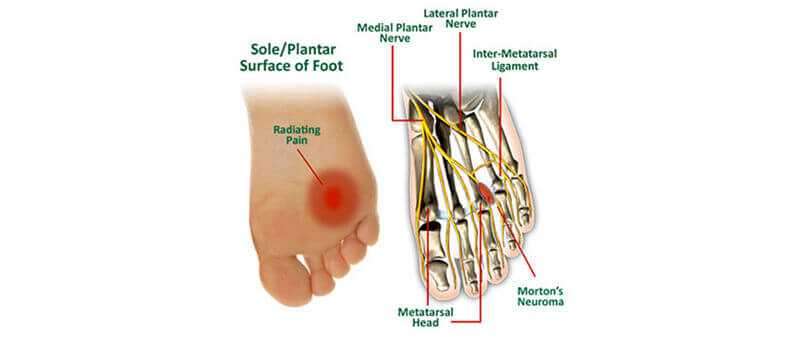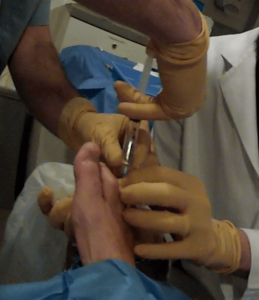It’s normal for your foot to hurt sometimes. You may have injured it while undergoing some type of physical activity or simply hurt it while accidently bumping your foot into an object.
But if that pain was not related to an injury and does not go away after several days, there might be something medically wrong that is causing your foot to hurt. One reason may be a condition called Morton’s neuroma.

Morton’s neuroma is a painful condition that affects the ball of one’s foot – commonly the area between your 3rd and 4thtoes, but can occur between other toes. The pain is often described as if the person has a rock in their shoe or on a bothersome fold in their sock.
Morton’s neuroma is caused by a compression and entrapment of a small nerve that runs between two toes and provides sensation to the area between the those toes. This compression results in irritation to the nerve and a Morton’s neuroma can form.
A person who has Morton’s often experiences a sharp, burning pain in the ball of their foot, and sometimes a stinging, burning or numbing feeling in their toes.
You will not see any outward signs (such as a lump) for a Morton’s neuroma. However, you will experience a burning pain in the ball of your foot that can spread to your toes, in addition to a tingling or numbness in your toes. In the beginning, the pain can be sporadic in nature lasting perhaps a few days, but as the condition progresses, one usually complains about the increasing amount of pain in their foot that doesn’t seem to go away.
The pain can be worse when you walk or run. For example you may be able to walk 10 or 15 minutes without pain but then the pain starts to set in.Sometimes it can become so bad that patients become frightened to even walk or bear any weight on their foot because of the excruciating pain they feel.
You should see a doctor if your foot pain lasts longer than a few days and make sure to describe the type of pain you’re feeling, as accurately as you can such as a burning pain in the ball of your foot. Tell you doctor what makes the pain better or worse.
But before you visit your doctor, try changing your footwear since shoes with a narrow toe box or high-heeled shoes are linked to the development of Morton’s neuroma. Lower-heeled shoes with wider toes boxes can provide relief for patients with Morton’s neuroma.
Other risk factors that contribute to Morton’s neuroma include: participating in high-impact physical activities such as running or jogging or wearing tight fitting shoes for certain sports like rock climbing since they can place extra pressure on your toes. Foot deformities like bunions, hammertoes, flat fleet or high arches are also risk factors for Morton’s neuroma.
A conservative approach to treatment is recommended at first such as a combination of orthotics and physical therapy. It is important that your orthotics be firm and have a good metatarsal arch. Even better, you may want to consider custom orthotics but these can be quite expensive. These simple measures are frequently combined with a corticosteroid injection.
If your corticosteroid injection provided you with long lasting pain relief (such as at least 4- 6 weeks of pain relief,) then you might consider having another injection if the pain reoccurs.
If your pain persists and a corticosteroid injection is inappropriate, not helpful or you’ve had a few and they becoming less effective, then you and your doctors should consider next steps.

A person suffering from Morton’s neuroma complains of severe pain in their foot, which is worse with weight bearing activities. There are good conservative measures for the treatment or early stage Morton’s neuroma such as orthotics, physical therapy and corticosteroid injections.
If the condition worsens or is not helped by these conservative measures,then you may want to consider next steps. These include a number of non-surgical procedures that are very effective in treating Morton’s neuroma.


By providing us with your information you are consenting to the collection and use of your information in accordance with our Terms of Service and Privacy Policy.